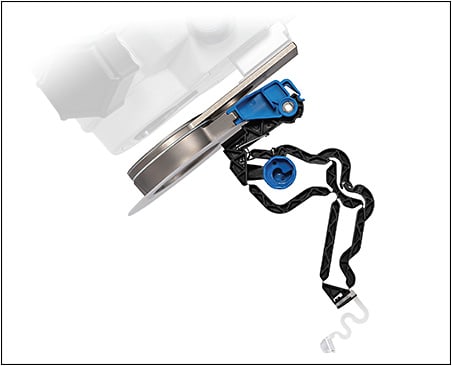The Gonio Ready lens from Oculus Surgical makes it possible to perform bimanual procedures during glaucoma surgeries.
“Unlike currently available handheld or self-stabilizing gonio lenses, the Gonio Ready lens attaches directly onto a surgical microscope, which frees up both of a surgeon’s hands to perform microinvasive glaucoma surgery (MIGS),” says Emily Lam, international sales manager of Oculus Surgical’s surgical division in Wetzlar, Germany.
Marissa Willemse, MBChB, MMed, FC Ophth (SA), ophthalmologist and president of the South African Glaucoma Society in Pretoria, South Africa, who uses the Gonio Ready lens at her practice, says, “Both cataract and posterior vitrectomy include bimanual techniques, and until now, MIGS was not bimanual because a hands-free gonio lens didn’t exist. Handheld lenses have some limitations. They require surgeons to have a steady hand and maintain very light pressure to prevent striae and indentation. Furthermore, the patient’s eye needs to be in a stable position to get a good view. With the new Gonio Ready lens, all these challenges are eliminated, making true bimanual surgery for glaucoma possible.”
The new visualization system is also the first single-use microscope-integrated gonioscopy system. Benefits of this include no risk of infection and no lost time for sterilization. “The optical quality of the lens is perfect every time,” Lam says. For high-volume clinics and emergency cases requiring quick turnover and setup, the Gonio Ready lens only needs to be removed from the box and clipped in.

Gain Access to Wide Angles
Much thought was given to the lens design. “A goal in our development process was to create a high-quality lens that offered clear visualization of anterior-segment structures,” Lam says. “The unique shape and small footprint maximizes ease of access for different instruments without sacrificing optical quality. Furthermore, the small lens size makes it versatile for different eye sizes and perfect for pediatric cases.”
A rotatable adapter plate allows users to adjust the Gonio Ready system to see further into an angle. “Anything that happens in an angle can be operated on more precisely using the Gonio Ready system,” Dr. Willemse says. For a procedure such as aspirating silicon oil out of an angle, which involve visualizing bigger structures through the lens, the surgeon can visualize up to 200° into the angle to see where droplets are located.
By having a good view of an angle, Dr. Willemse can also use the device to restore the iris into the right plane. “Having 2 hands is very helpful in loosening up adhesions or even repositioning a malplaced IOL haptic in the angle,” she says. Oncology ophthalmologists can use the device to operate on iris melanomas, and iris nevus procedures can be performed with much more precision with 2 free hands, Dr. Willemse adds.
Flexibility Is a Key Feature
The Gonio Ready lens attaches to a microscope via an adapter with a flexible “swan neck,” referred to as the “Flex System.” The system is flexible enough to be moved around during MIGS, yet resistant enough to movement that it won’t be inadvertently displaced.
For example, the device’s flexibility gives it tolerability toward eye movement and torsion; the lens will stay on the eye even when a patient or the microscope moves slightly. It’s also tolerant of all eye shapes and sizes, and differing angles of the eye, Dr. Willemse says.
Another benefit of the Flex System is that no extra pressure is put on the cornea during procedures, which reduces the risk of corneal striae formation, Lam says.
Easy to Use
The Gonio Ready lens can be attached to any ophthalmic microscope, requiring only an adapter plate that can remain attached to a microscope. The adapter system is the same as that of Oculus Surgical’s Biom, which provides wide-angle observation of the fundus during vitreous surgery.
The Gonio Ready lens can be easily repositioned through the connected footswitch. Surgeons may want to use their free hand to stabilize and position a patient’s head or eye, insert a second instrument, or stabilize the entry and positioning of their dominant hand, Lam says. “Without having to set down any instruments in hand, a surgeon is free to change the positioning of the lens as necessary to access different parts of the eye,” she explains.
By having 2 free hands, Dr. Willemse says she can now have a second instrument in the anterior chamber. For example, she can open Schlemm’s canal with viscoelastic before inserting a device. The Gonio Ready lens also works just as well for right-handed and left-handed operators; surgeons are free to switch their hands whenever desired.
According to Konrad Schargel, MD, an early adopter who is the glaucoma division chairman at King Khaled Eye Specialist Hospital in Riyadh, Saudi Arabia, the Gonio Ready lens will make gonio procedures safer. “The device will open new doors to many unimagined possibilities for surgeons,” he says. “It can also be used to train young physicians and make their entry into the MIGS world much easier.”
Concludes Dr. Willemse, “The Gonio Ready lens is revolutionizing surgery in the anterior chamber. The future of glaucoma surgery will expand because we now have 2 hands on board.” GP








